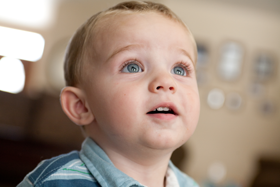
After a severe head injury that resulted in a blood clot about the size of a tennis ball, Dylan Shaeffer lives up to his “little trooper” reputation.
Abby Shaeffer, 30, was in her dental hygiene class at Southwestern College when she got the call no mother ever wants to receive. Her sister-in-law, Wendy Gilbert, was babysitting her 1-year-old son, Dylan, and 3-year-old son, Weston, in her Alpine home. She called to tell Abby that Dylan had slipped and fallen on her tile floor and struck his head. He was unconscious and she couldn’t wake him, so she called 911.
“She was kind of in shock because the paramedics came in and scooped him up and said they were taking him to Rady Children’s,” says Abby. “I was hysterical and didn’t know what to think. A friend drove me so I could call my husband, Brian.”
Ironically, Brian, 39, a foreman for A.O. Read & Company, was working on the new Acute Care Pavilion at Rady Children’s when she called. He rushed over to the Sam S. and Rose Stein Emergency Care Center, and Abby met him where ambulance patients are brought in.
“I didn’t think it was a big deal at first,” says Brian. “But after about 15 minutes when his ambulance hadn’t come, we asked where he was. A social worker told us he had stopped breathing, but paramedics were breathing for him and stabilizing him before they brought him in by helicopter from Alpine. That’s when Abby and I freaked out.”
“The people on the Trauma team are just amazing,” says Abby. “There was always someone there helping us – we were never left alone.”
Sue Cox, director of Trauma and Volunteer Services, says the Trauma Team met the helicopter. The full Trauma Care Center team consists of three attending physicians, two trauma trained nurses, a respiratory therapist, a social worker, a laboratory technician, a radiology technician and a pharmacist. One of the paramedics said Dylan had been posturing when they arrived at the house. After a rapid physical assessment by the team, Dylan was immediately taken for a CT scan.
“Posturing is evidence of a brain injury,” explains Cox. “The child stiffens and has spastic-type movements of his extremities. We did a CT scan and notified Dr.Michael Levy, director of our neurosurgery department.”
The CT scan showed bleeding between the left side of his brain and the covering of the brain – a left subdural hematoma. Dylan was rushed to an operating room because the bleeding could injure the brain, possibly causing death.
Dr. Levy says the skull is a closed box that contains brain, blood and cerebral spinal fluid. If you increase one, you need to decrease components of the other. The team would have to decrease pressure in the brain by surgically removing the blood.
In the 76-minute operation, they removed a plate from Dylan’s skull, opened up the covering of the brain, and precisely removed the clot and let the blood out. Then they closed the covering of the brain and sewed the skull bone back on.
“Because the child was so young, the procedure was very dangerous, but our Trauma team got the child in quickly, did a quick CT scan and got him to the OR where we could remove the blood quickly – that’s what saved his life,” says Dr. Levy. Because of that, this child should have an entirely normal life.”
Abby and Brian agreed everything happened very quickly. The CT scan showed a blood clot about the size of an orange. Within 30 minutes of the CT scan, the team had Dylan in surgery. The accident happened at 12:45 p.m. and he was in surgery by 3 p.m.
Dylan stayed two nights in the ICU and one night in Ernest Hahn Critical Care Center.
“On the second night in the ICU, he woke up smiling and talking and wanting something to eat,” says Abby. “I was so excited he bounced back so quickly that I called Brian and cried and told him I think our baby’s back.”
She said Dylan scheduled a follow-up appointment with Dr. Levy in September to see if his head is forming properly. Right now, they can’t see any side effects from the surgery.
Cox explained that the San Diego Trauma System is nationally and internationally known for its organized and timely response to injured patients with its excellent pre-hospital system and trauma hospitals and teams.
This year, the Trauma Center at Rady Children’s is celebrating the San Diego Trauma System’s 25th anniversary. Rady Children’s Trauma Center partners with five adult trauma centers and San Diego County Emergency Medical Services to focus on excellent care and to continually improve trauma care in our region.
The preventable death rate before the Trauma System in San Diego was instituted was 21.5 percent; now it is 2 percent overall in the system,” Cox said. “I think that speaks to the collaboration, scrutiny and sharing best practices of the system.”
Abby and Brian believe the trauma system saved Dylan’s life.
“We went back to visit the paramedics after Dylan was home,” says Abby. “They said, when they arrived and saw him, they only gave him a 10 percent chance to survive. A fireman told us he wasn’t going to hold his breath because he didn’t think our son was going to make it. But just look at him now – he’s doing amazingly well. He’s our little trooper – our angel baby.”
The San Diego Union-Tribune Kids’ NewsDay, October 2009